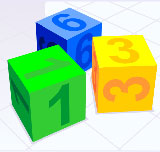1. Numerical calculations
From Förberedande kurs i matematik 1
| \displaystyle \text{@(a class="image" href="http://smaug.nti.se/temp/KTH/film3.html" target="_blank")@(img src="http://wiki.math.se/wikis/2008/forberedandematte1/img_auth.php/0/00/Lars_och_Elin.jpg" alt="Film om tal")@(/img)@(/a)} |
What is a number and who invented the four basic arithmetic operations?
Watch the video in which the lecturer Lasse Svensson tells us how arithmetic developed and answers Elins questions.
This first part of the course is about numerical calculations, that is, calculations with numbers. Another name for this is arithmetic.
Arithmetic is the study of the properties of numbers and the four basic operations: addition, subtraction, multiplication and division. We usually separate mathematics into different branches or areas and arithmetic is one of those branches. Other branches are for example: algebra, geometry and the theory of functions. The word arithmetic comes from the Greek "arithmos" meaning "number" and the ending -ic means "knowledge". Thus the original meaning was "knowledge of numbers."
We begin with a discussion of various kinds of numbers and the usual basic operations. The numbers originated in measurements of various kinds (animals in an enclosure: 17 sheep, credit: -250 EURO, amount per guest: 1 / 8 cake, perimeter of the circle: 2 cm.).
The basic arithmetic operations are structured in a hierarchy that begins with addition and its opposite, subtraction. Following on from addition we have multiplication which is addition repeated several times. The opposite operation to multiplication is division.
If one continues in the same way the next operation is exponentiation or raising to a power which can be considered as a multiplication repeated several times. The reverse operation to this is to take the root of a number. Even logarithms can be regarded as a reverse operation to exponentiation. (This you can read about in Part 3 Roots and Logarithms.)

It is important to note that the material in this section — as well as in other parts of the course — is designed so that one does not use calculators.
When you get to university you will not be allowed to use calculators during your "exams", at least this is true for the basic courses. For advanced courses in mathematics one has hardly any use of calculators as the mathematics is more about understanding principles than performing calculations. For example, it is more important to understand why 7 + 3 is the same as 3 + 7 than to be able to carry out the additions and obtain the answer 10.
To do well in arithmetic
- Start by reading the section's theory and study the examples.
- Work through the exercises and try to solve them without using a calculator. Make sure that you have the right answer by clicking on the answer button. If you do not have it, you can click on the solution button to see what went wrong
- Then go ahead and answer the questions in the basic test of the section.
- If you get stuck on a point, check to see if someone else has discussed the point in the forum belonging to the section. If not, take up the point yourself. Your teacher (or a student) will respond to your question within a few hours.
- When you are finished with the exercises and the basic test in a section you should take the final test to get a pass for the section. The requirement here is to answer correctly three questions in a row before you can move on to the next section.
- When you have answered correctly all questions in both the basic and the final test of this section you will have a pass for this section and can move on to Part 2 of the course.
PS. You must answer all the questions correctly for both the basic and the final test, but you may do a test several times. Even if you do not succeed in passing a test at first attempt, it is your last results, which appear in the statistics. If you feel that you are familiar with the contents of a section you can go directly to the basic and final tests.
